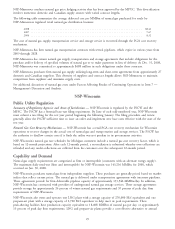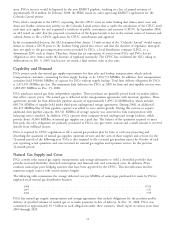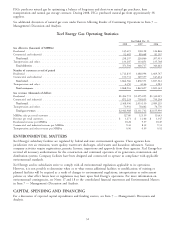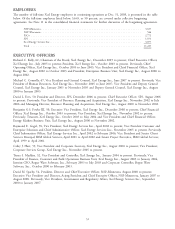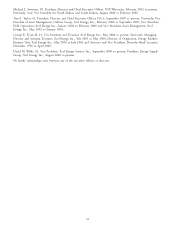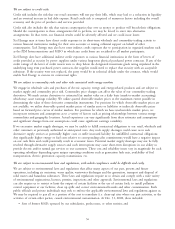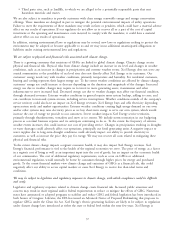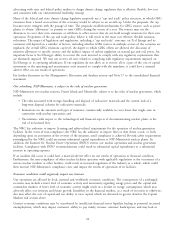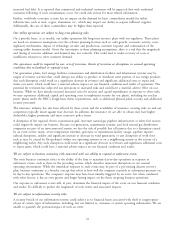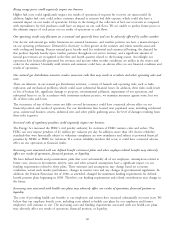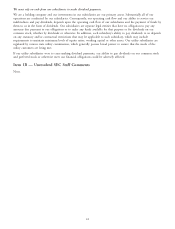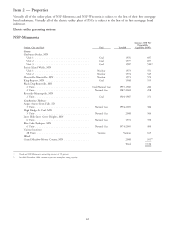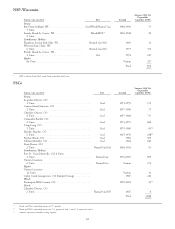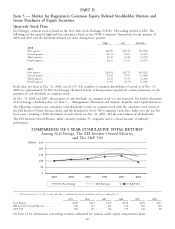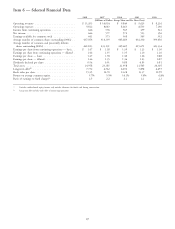Xcel Energy 2008 Annual Report Download - page 49
Download and view the complete annual report
Please find page 49 of the 2008 Xcel Energy annual report below. You can navigate through the pages in the report by either clicking on the pages listed below, or by using the keyword search tool below to find specific information within the annual report.increased bad debt. It is expected that commercial and industrial customers will be impacted first with residential
customers following, if such circumstances occur. See credit risk section for more related information.
Further, worldwide economic activity has an impact on the demand for basic commodities needed for utility
infrastructure, such as steel, copper, aluminum, etc., which may impact our ability to acquire sufficient supplies.
Additionally, the cost of those commodities may be higher than expected.
Our utility operations are subject to long term planning risks.
On a periodic basis, or as needed, our utility operations file long term resource plans with our regulators. These plans
are based on numerous assumptions over the relevant planning horizon such as: sales growth, economic activity, costs,
regulatory mechanisms, impact of technology on sales and production, customer response and continuation of the
existing utility business model. Given the uncertainty in these planning assumptions, there is a risk that the magnitude
and timing of resource additions and demand may not coincide. This could lead to under recovery of costs or
insufficient resources to meet customer demand.
Our operations could be impacted by war, acts of terrorism, threats of terrorism or disruptions in normal operating
conditions due to localized or regional events.
Our generation plants, fuel storage facilities, transmission and distribution facilities and information systems may be
targets of terrorist activities that could disrupt our ability to produce or distribute some portion of our energy products.
Any such disruption could result in a significant decrease in revenues and significant additional costs to repair and
insure our assets, which could have a material adverse impact on our financial condition and results of operations. The
potential for terrorism has subjected our operations to increased risks and could have a material adverse effect on our
business. While we have already incurred increased costs for security and capital expenditures in response to these risks,
we may experience additional capital and operating costs to implement security for our plants, including our nuclear
power plants under the NRC’s design basis threat requirements, such as additional physical plant security and additional
security personnel.
The insurance industry has also been affected by these events and the availability of insurance covering risks we and our
competitors typically insure against may decrease. In addition, the insurance we are able to obtain may have higher
deductibles, higher premiums and more restrictive policy terms.
A disruption of the regional electric transmission grid, interstate natural gas pipeline infrastructure or other fuel sources,
could negatively impact our business. Because our generation, transmission systems, and local natural gas distribution
companies are part of an interconnected system, we face the risk of possible loss of business due to a disruption caused
by an event (severe storm, severe temperature extremes, generator or transmission facility outage, pipeline rupture,
railroad disruption, sudden and significant increase or decrease in wind generation, or any disruption of work force
such as may be caused by flu epidemic) within our operating systems or on a neighboring system or the actions of a
neighboring utility. Any such disruption could result in a significant decrease in revenues and significant additional costs
to repair assets, which could have a material adverse impact on our financial condition and results.
We are subject to business continuity risks associated with our ability to respond to unforeseen events.
The term business continuity refers to the ability of the firm to maintain day-to-day operations in response to
unforeseen events, such as those in the preceding section, which describes numerous disruptions to our normal
operating environment. While the immediate response to such events may be part of a pre-existing disaster recovery
plan, business continuity is a broader concept that refers to how well the company responds to subsequent pressures on
its day-to-day operations. The company’s response may have been initially triggered by an event, but when combined
with other factors, it has an even greater and longer lasting impact on the firm’s on-going business operations.
Our response to unforeseen events will, in part, determine the financial impact of the event on our financial condition
and results. It’s difficult to predict the magnitude of such events and associated impacts.
We are subject to information security risks.
A security breach of our information systems could subject us to financial harm associated with theft or inappropriate
release of certain types of information, including, but not limited to, customer or system operating information. We are
unable to quantify the potential impact of such an event.
39


